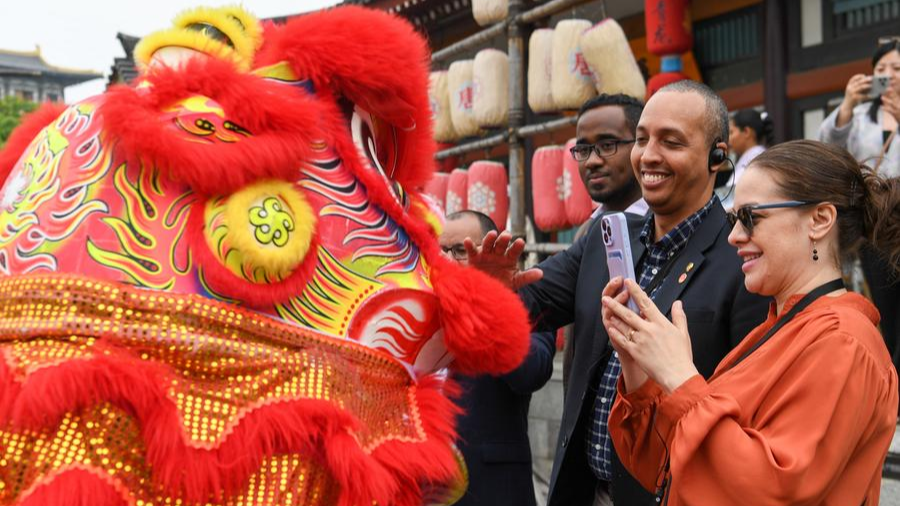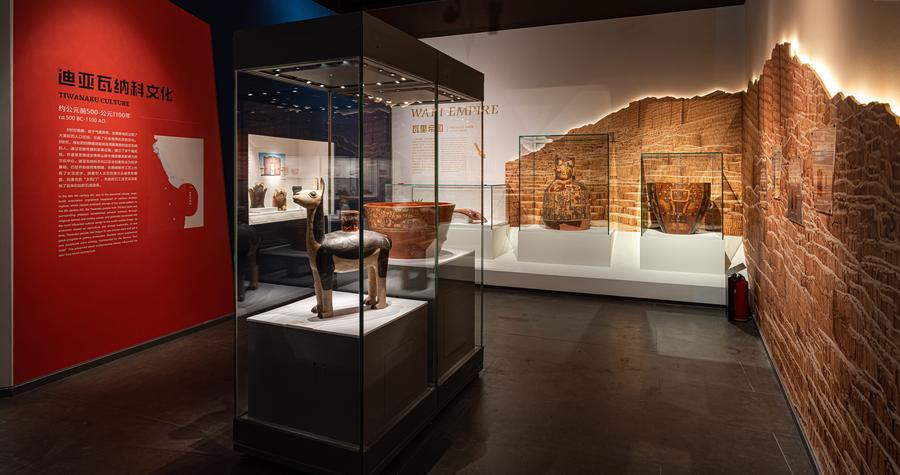
Members of a delegation of diplomats and journalists from Latin American and Caribbean countries visit an ancient town in Xiangyang, central China's Hubei Province, April 22, 2024. /Xinhua
Editor's note: Pan Deng, a special commentator on current affairs for CGTN, is vice president and Secretary-General of Chinese National Association of Returned Scholar from Ibero-American and Caribbean countries and the director of the Latin America and Caribbean Region Law Center of China University of Political Science and Law. The article reflects the author's opinions and not necessarily the views of CGTN.
The second China-Latin America and Caribbean States Roundtable on Human Rights, scheduled in Brazil today, will weave a compelling new thread in the intricate tapestry of global human rights governance, which has been largely shaped by the West.
China and Latin America collectively represent approximately one-fifth of the world's landmass and nearly one-third of its population.
Despite notable differences in their development paths and mainstream societal values, a common narrative is emerging based on their shared history and explorations. This narrative rejects the politicization and ideological misuse of human rights issues and instead embraces mutual respect and understanding.
Different history, common ground
To understand the differences in China and Latin America's approach to human rights, their unique civilizational roots and historical paths have to be taken into consideration. For China, a century of humiliation in modern history heavily shaped its views on national sovereignty, independence and the right to development. The Chinese perspective emphasizes a dialectical unity between "collective human rights" and "individual human rights," born from suffering foreign aggression and struggling for survival. It highlights "survival" as the most fundamental and urgent human right and veiws the right to development as the basis for all other rights.
China's remarkable economic growth over the past few decades, which has lifted hundreds of millions out of poverty and expanded education, healthcare and social security, is seen as a prime example of advancing human rights through development.
Most Latin American nations, after gaining independence from colonial rule, went through military dictatorships and economic dependency, experiencing the deprivation of civil and political rights, democratic freedoms and developmental opportunities.
Some of them have also long dealt with external pressures, which has led them to emphasize national sovereignty and self-determination. Therefore, their human rights demands also include seeking an end to the "inhumanity of economic sanctions," which has garnered recognition and sympathy from many countries, including European nations.
These divergent historical experiences and development paths have led to different priorities and implementation strategies for human rights in China and Latin America. China understands that Latin American countries attach great importance to democracy and civil rights, which is closely related to their anti-dictatorial history. Simultaneously, Latin American nations have also increasingly better understood China's logic of promoting human rights through development and prioritizing collective well-being.
This mutual understanding creates a healthy environment for human rights dialogue by reducing misjudgments and prejudices. It lays the groundwork for shared discourse on certain issues and offers possibilities for exploring a more inclusive model of global human rights governance.
Diverse pathways, shared aspirations
The right to development and the right to subsistence, as basic human rights, constitute the most spontaneous common discourse between China and Latin America.
Both generally agree that in a world still grappling with poverty, imbalanced development and climate change, safeguarding people's right to survival and development is a prerequisite for realizing all other human rights. Without economic and social development, all other rights will remain unfulfilled.
Their strongest consensus is on opposing the instrumentalization of human rights and double standard. Both oppose the use of human rights issues by a few nations as a tool to interfere in the internal affairs of other countries, exert pressure, or contain them. They agree that such practice not only violates the fundamental principles of international law but also undermines the healthy development of the international human rights cause, leading to antagonism and division in human rights dialogue.
Both have been urging the UN's human rights bodies to uphold the principles of fairness, objectivity and non-selectivity, to return to the essence of human rights issues, and to reject double standard.
The most conscious practical consensus between the two is to advocate cultural diversity and reciprocity. Both believe there is no one-size-fits-all model for human rights development. The path to safeguarding human rights should align with each country's national conditions and historical and cultural traditions. All countries have the right to choose their own path to human rights development and should respect and learn from each other. This respect for civilizational diversity is a powerful response to the single narrative of "universal human rights" often presented by the West and it creates space for different countries to explore the human rights path that suits them.
Having understood their historical differences and common ground, the China-Latin America relationship is exploring a new paradigm of "seeking common ground while reserving differences and engaging in dialogue and cooperation" on human rights issues. Both recognize that while disagreements may exist on certain specific human rights concepts or practices, these should not impede dialogue and cooperation.

An exhibition on South America's Inca civilization at the Jinsha Site Museum in Chengdu, southwest China's Sichuan Province, January 9, 2024. /Xinhua
A new human rights cooperation paradigm
Despite Western nations largely dominating the international human rights discourse, China and Latin America are strengthening human rights dialogues within bilateral and multilateral frameworks. These dialogues go beyond accusations and defenses, delving into the experiences, challenges and achievements of their respective human rights practices.
For instance, China can share its experiences in poverty alleviation, healthcare and compulsory education, while Latin American countries can share their experiences in democratic construction, judicial reform and civil society development. Through such candid exchanges, both can learn from each other and collectively enhance their human rights protection.
Their interaction on human rights issues is a vibrant chapter in seeking commonalities amidst historical differences and inspiring each other through their respective explorations. It challenges the Western single human rights narrative, showcasing the diversity and complexity of global human rights development paths, and exemplifies promoting human rights through dialogue rather than confrontation, inclusion rather than exclusion and practical action rather than empty rhetoric.
The human rights dialogues between China, the world's largest developing country, and Latin America, one of the regions with the highest concentration of developing countries, also demonstrates that there isn't a single model for human rights realization, and different countries, at various historical stages and in different cultural backgrounds, can explore unique and effective paths to human rights protection.
By respecting each other's explorations, acknowledging historical differences and expanding common ground through deeper dialogue and cooperation, the two partners can not only better fulfill the human rights aspirations of their own people but also jointly contribute a "China-Latin America solution" to promote more just, balanced and inclusive international human rights governance.


